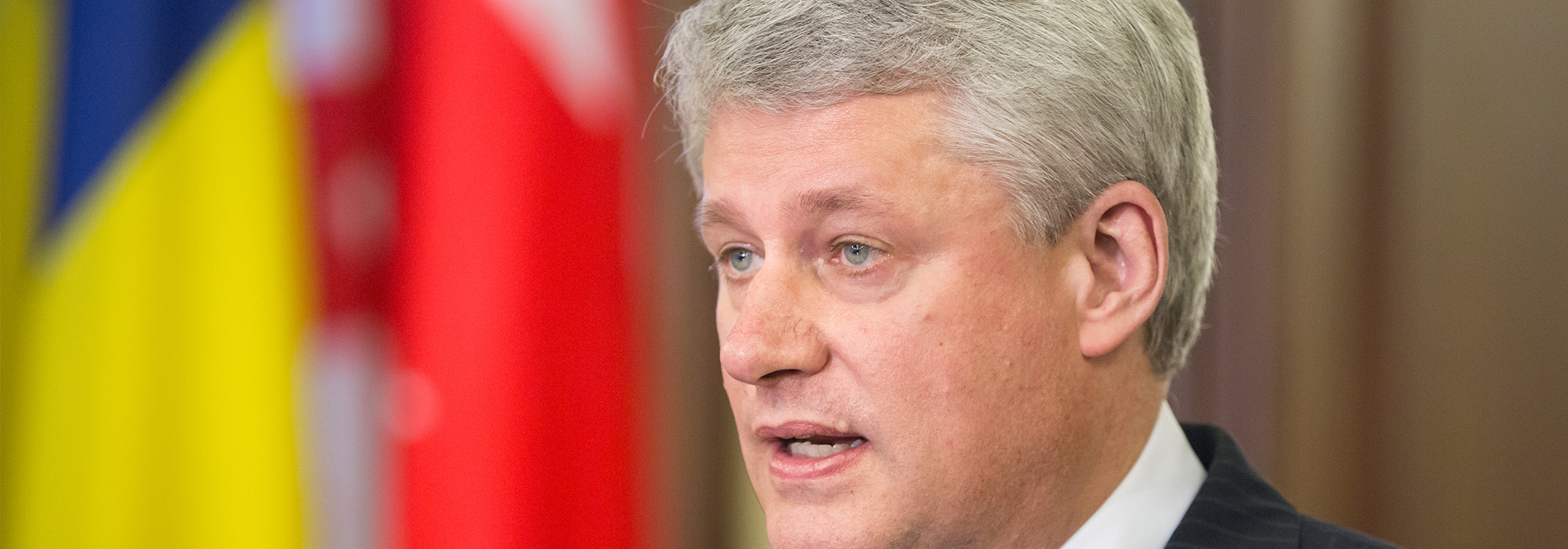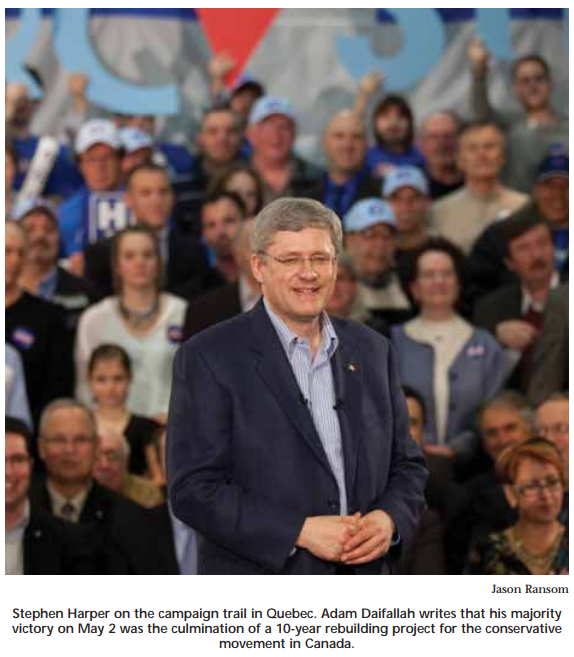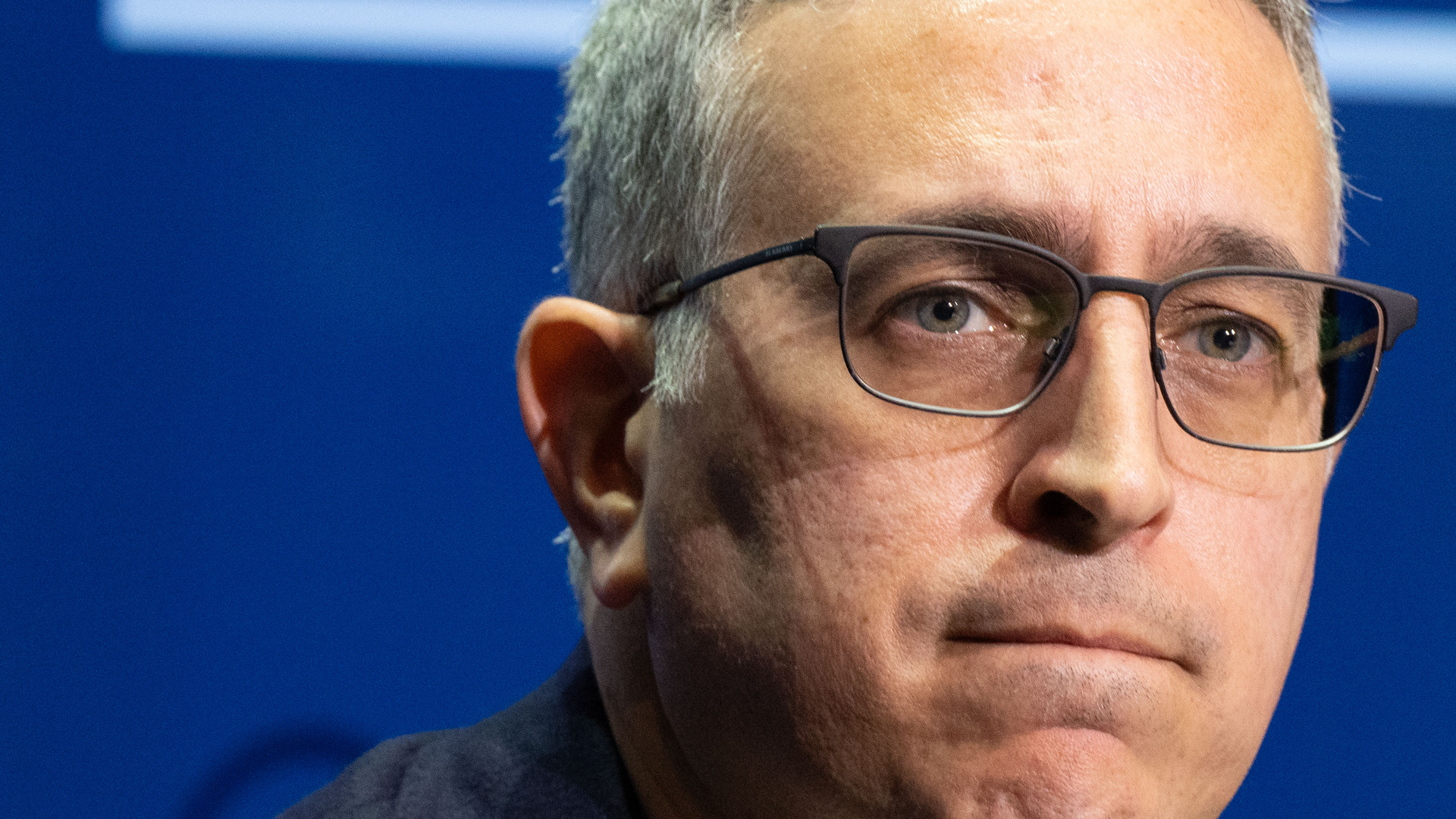
The people who know Stephen Harper best say the word that describes his mood the night of May 2 is relief. Just shy of 10 years since his return to electoral politics, Harper found himself at the helm of a majority government. How far the Conservative Party and the right have progressed in last decade is nothing short of remarkable, but there is more work to be done.
First, the Conservative Party. Ten years ago, I co-wrote a book (with Peter G. White) called Gritlock: Are the Liberals In Forever? Today, the title alone brings out a smile. At the time, however, it really did look like the Liberals were a permanent governing party. Jean Chrétien had won three straight majorities, the right was still divided and there was little hope of reconciliation.
The catalyst in changing the course of our federal political narrative was Stephen Harper’s decision to return to politics to run for the leadership of the Canadian Alliance in 2002. He came back to accomplish two goals. The first was to unite the Alliance and Progressive Conservatives to create a single viable alternative to the governing Liberals. The second was to make the Conservatives the new natural governing party. He accomplished the first with great gusto (keeping the party glued together post-merger was no small feat either) and the 2011 election results demonstrate he may be on his way to fulfilling the second.
Since Harper’s been in charge, his record, seen as a whole, is nearly flawless: winning the Alliance leadership in 2002, uniting the right in 2003, finishing second and learning hard lessons but forcing the Liberals into minority status in 2004, winning a minority in 2006, an enlarged minority in 2008, and now finally a majority in 2011, all the while growing his share of the national vote from 30 percent in 2004 to nearly 40 percent in 2011. The once-mighty Liberals have been reduced to third-party status and the Bloc Québécois, which some believed had become a permanent national presence, is now completely out of the game. Harper won 166 seats on May 2, up from 143 in 2008, 124 seats in 2006 and 99 in 2004. Harper may be a tortoise, but as in Aesop’s fable, he’s won the race.
Harper deserves the lion’s share of the credit for the Tories’ meteoric rise. But the Liberals have given him gifts of self-inflicted wounds. The sponsorship scandal lingers, their fundraising apparatus has not adapted to the post-corporate donation era, they are internally divided, and they have fallen for the “messiah” myth, mistakenly believing that their ills could be cured by the magical appearance of a star leader. All you need to know about the current state of the Liberal Party is that since 1867, only three of its leaders have never become prime minister, including the last two, Stéphane Dion and Michael Ignatieff. The first was Edward Blake, who resigned in 1887.
The 2011 election may go down as the Liberals’ 1993 moment. They are now the second opposition party for the first time in history, the denouement of a long and gradual decline that has been in the works since the Trudeau era or earlier. It can’t — and won’t — get worse. Perhaps this voter-imposed body blow will finally jolt the Liberals into taking advantage of their wilderness years the way they should. Until now, many senior Liberals never accepted that their recent losses were anything but a quick trip to the penalty box. Now they will have at least four years — and likely longer — to redefine a vision of who they are and what they stand for.
Politics is, if anything, unpredictable. That’s part of what made the last five years fun. The Tories seemed to be grasping onto power by the slimmest of margins for a long time. Before you knew it, it actually was a long time: by the time he’s done, Stephen Harper will have led this country for at least nine years, and possibly much longer. He has gotten to this point through extreme patience, hard work, perseverance and, perhaps most importantly, a razor-sharp focus on the long term despite the daily challenge of survival in minority parliaments.
In the 2004 losing campaign, Harper’s first, a number of amateur mistakes were made. Harper was unfocused and appeared to have a pessimistic outlook. But after briefly considering quitting after that loss, Harper regrouped. He’s made few serious errors since.
Just before the 2006 election, Tasha Kheiriddin and I released Rescuing Canada’s Right: Blueprint for a Conservative Revolution. The book had two aims: first, to advise the Conservative Party on how it could improve its electoral prospects and what policies it should propose. The second was to recommend how to build a powerful, nonpartisan conservative movement in Canada, similar to the one that had been so successful for four decades in the US.
Harper deserves the lion’s share of the credit for the Tories’ meteoric rise. But the Liberals have given him gifts of self-inflicted wounds. The sponsorship scandal lingers, their fundraising apparatus has not adapted to the post-corporate donation era, they are internally divided, and they have fallen for the “messiah” myth, mistakenly believing that their ills could be cured by the magical appearance of a star leader.
While we can’t claim credit for Harper’s moves in office, some of the suggestions the book put forward have been implemented. One key point — and in my view a much-overlooked factor in Harper’s success — has been his emphasis on a positive, patriotic narrative. Pre-2006, Harper appeared (or was at least perceived to be) negative about Canada. In the time since, he has become an eternal optimist, even running a TV ad in the 2011 campaign that mirrored Ronald Reagan’s famous 1984 “Morning in America” commercial. Conservatives do well when they offer hope for the future, not when they seem downbeat.
Another point has been the professionalization of the Conservative Party. Before Harper first won, the Tories had a weak, gaffe-prone communications operation. Since winning government, the Conservatives have (for better or for worse) become a case study for what a professional political organization looks like, from its tight scripting to message control to the way in which it has defined its political opponents, especially the last two Liberal leaders. It would be difficult to find another political party in the Western world today that has a better-oiled communications machine than Harper’s Tories.
On policy, the Tories have had mixed reviews, with the sharpest criticisms coming from fiscal conservatives. Criticisms have focused on trade protectionism (case in point: the government’s blocking of the sale of Potash Corporation), pandering to Quebec, support for regional development, increases in Equalization payments, the 2009-10 stimulus package and the more general lack of fiscal restraint. According to the Fraser Institute, program spending under Harper has increased by an average of 7.2 percent per year. Overall program spending is up nearly 40 percent since Harper took office.
“In Ottawa, no party stands for less intrusive government and more disciplined spending. Chances of lower taxes and greater reliance on private enterprise and markets in key economic sectors are now out of reach… The possibility of smaller bureaucracies and fewer subsidies to claques of handout-seekers is all but unthinkable. Terence Corcoran recently wrote in the Financial Post.
Other Harper critics, including Gerry Nicholls and Andrew Coyne, have labelled the government “Liberal-Lite” and accused it of governing without principle.
That’s too harsh. Tom Flanagan, a man who knows Harper well and ran his 2004 campaign, has written at length about Harper and the median voter theory. According to Flanagan, Harper cannot be expected to veer too far right ideologically for fear of alienating average voters. Harper’s philosophy is to situate the Conservatives slightly to the right of the median voter on key policy matters, and no more. That strategy, along with his campaign team’s mastery of hypersegmenting and targeting various blocs of the electoral base, has worked.
Spending has undoubtedly been the Harper government’s greatest conservative shortfall, and unfortunately, there is no sign this trend will change. To be sure, the challenge to rein in spending has been a conservative failure from Thatcher to Reagan to Mulroney. But Canadian conservatives who have patiently waited as the Tories blamed high spending on temporary stimulus programs during the financial crisis and on the imperatives of governing with a minority will be watching carefully to see if Harper can be a leader in this area.
Some solid policy advancements have been made. Taxes have been cut: the lowest bracket was reduced from 16 percent to 15 percent, the GST has been lowered from 7 percent to 5 percent, corporate rates are down to 16.5 percent and will soon be at 15 percent. The GST move has been criticized by many as being unsound fiscal policy — at a time when the Canadian population is aging, smart public policy would be to maintain or even increase consumption taxes. But, a tax cut is a tax cut.
Harper’s penchant for what have been dubbed “boutique” tax credits — the strategy of offering targeted tax relief to key voting demographics — is also questionable from a conservative perspective. Added up, these credits don’t amount to much savings: the children’s fitness tax credit, the public transit tax credit, the first-time-home buyers’ tax credit, the children’s arts tax credit and so on. Some see these moves as social engineering — as government unjustly involving itself in trying to incentivize certain types of behaviour. They’re not my preferred tax cuts, but they are still moving in the right direction.
Our book’s recommendation for abolishing the Court Challenges Program was adopted. While it was only a small program with a limited budget, terminating it was symbolically significant.
Our call to reach out to new Canadians — a natural conservative constituency — has been accomplished with great gusto by Immigration Minister Jason Kenney. To see the results, one need only see the Conservatives’ seat gains in the GTA in the election. The Tories went from 0 to 9 seats in the 416 area code and a great deal of the credit must go to Kenney.
The Federal Accountability Act stands out as one of Harper’s key accomplishments. The law was passed as a severe response to the Liberal sponsorship scandal, providing whistle-blower protection, strengthening access to information and banning lobbying for ex-political staff for five years after leaving government. The law has been criticized as being too harsh; it made life a nightmare for Ottawa lobbyists and has contributed to a lack of experienced staff wanting to work in federal ministers’ offices.
The tough-on-crime approach adopted by Harper (12 bills have been adopted, including a “truth in sentencing” law) is popular with voters, although it divides conservatives. Conrad Black, for example, has been a strident opponent of Harper’s crime policies, particularly the planned building of so-called “superjails.”
The greatest strides for conservatism may be those in foreign policy. Canada under Harper has outshone all of its Western allies in its robust defence of democracy, freedom and human rights abroad. In the face of opposition from the foreign policy establishment, Harper has jettisoned the pragmatic “soft power” approach of his predecessors. Harper’s principled approach includes stronger support for the war on terrorism and for Israel. The Conservatives decided not to participate in the Durban II anti-racism conference because, as stated by Immigration Minister Jason Kenney, “it was showing all signs that it would degenerate into an open anti-Semitic hatefest.” Foreign Affairs Minister Lawrence Cannon vacated his seat at the start of Iranian President Mahmoud Ahmadinejad’s speech to the UN General Assembly in 2009. And Canada was the first government in the West to cut funding to the Hamas-led government in the Palestinian territories.
Another of the shifts seen under Harper is very difficult to quantify: it’s the overall change in tone. It’s the decisions on what events and issues he chooses to emphasize, and those that are not on the priority list. For example, when was the last time you heard a federal cabinet minister refer to the Charter of Rights in a speech? Harper chooses to give prominence to issues and themes that please a conservative voter base, such as the military, bravery, commemorative dates, and the Canadian North. This gradual and very subtle shifting of emphasis to certain symbols of Canadian identity over others is one of Harper’s greatest achievements, one that has laid the groundwork for the advancement of conservatism in the years ahead.
The Conservative Party, then, is in very good shape — both financially and otherwise. But it needs a robust extra-partisan conservative movement to keep it honest. John O’Sullivan, the one-time editor of National Review, came up with something called O’Sullivan’s First Law, which states that organizations that are not actively right-wing will over time become leftwing. Without constant pressure from outside forces, governments grow — even conservative-minded ones.
Rescuing Canada’s Right’s call for a more organized conservative movement outside Ottawa has been a success beyond imagination. Indeed, there is a veritable conservative spring occurring. Just as it would have been funny to think of the Conservative Party winning government 10 years ago, it would have even more funny to think that the US conservative movement would look to Canada for any sort of inspiration — yet it does.
Some of the credit must be given to Preston Manning. In 2005, Manning and a group of activists and businesspeople founded the Manning Centre for Building Democracy, which serves as a sort of mothership for the movement, helping and mentoring conservative groups, training activists and hosting an annual networking conference in Ottawa.
On ideas generation, Canada is second to none. From the Fraser Institute in Vancouver to the Frontier Centre in Winnipeg to the Montreal Economic Institute to the Atlantic Institute for Market Studies, a slew of organizations are busy promoting freedom and free markets. Brian Lee Crowley recently launched the Macdonald Laurier Institute, which has emerged as an important Ottawabased freedom-minded think tank.
On the media front, the recent launch of Sun News Network has given conservatives hope. Initial reviews of the network have been mixed, but it is still a station that the centre right can call its own. Conservative-minded journalists pepper the opinion pages of all major daily newspapers in the country.
Where the movement needs to focus its attention now is on activist organizations that can take conservative ideas and give them more popular appeal. The Canadian Constitution Foundation, founded in 2002, has become a high-profile organization fighting for freedom in courtrooms. They are doing great work. The Canadian Taxpayers’ Federation remains a high-profile voice fighting government waste and inefficiency. But there is a crying need for groups that will attack bad public policy from the right. The National Citizens’ Coalition, which once valiantly performed this role, is a shadow of its former self. We need more groups that are like them who can attract attention and help popularize causes such as private health care.
The conservative movement’s challenge for the next five years is to build on its strengths and continue working to convince Canadians of the merits of conservative ideas. Canadians still need to better understand conservatism and why it is in their interests to have government enact conservative policies.
The Conservative Party’s challenges are different. With a healthy majority and an official opposition that will likely be rather nonthreatening, it will be easy for it to be come complacent. Indeed, at this point, it’s hard not to see Harper winning again in four years. The Liberals will not recover from this setback overnight, and assuming the Tories pass their previously proposed seat redistribution legislation, another 30 seats will go to Ontario and the west, where the Tories are already strong.
The issue they should focus hard on, other than long-term policy development, is improving their status in Quebec. The Tories went from 11 to 5 seats there, and saw a decrease in their popular vote from 21.7 percent in 2008 to only 16.5 percent this time. Harper could start by naming one of his Quebec caucus members to be Quebec lieutenant with the sole mandate of improving the party’s standing in la belle province. Harper should also spend a lot of time this summer attending BBQs in the areas where the party lost seats in the hopes of winning them back next time.
The Conservative Party and the conservative movement have both come a long way. There’s still a long way to go, however, and that work starts now.
Photo: Shutterstock








